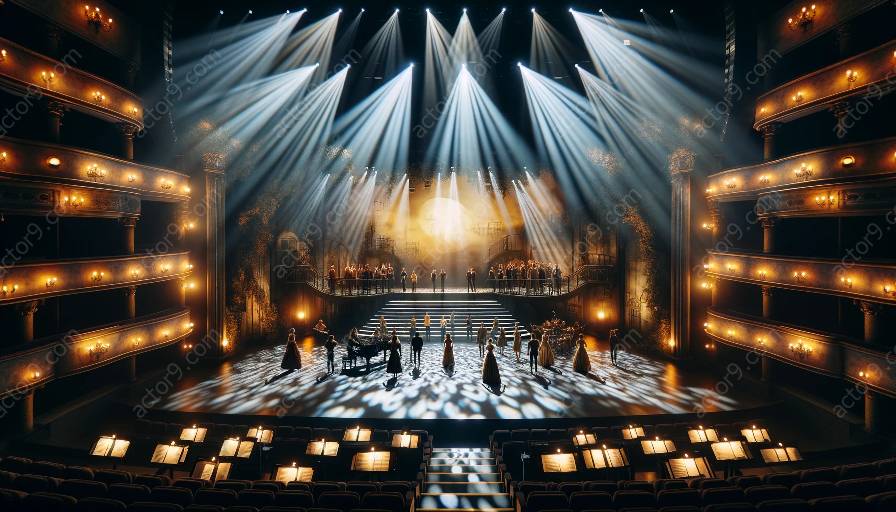Visual composition and balance are essential elements in creating captivating and engaging musical theatre performances. In this discussion, we will explore the concepts of visual composition and balance, their significance in lighting design, and their impact on the overall experience of musical theatre.
Visual Composition
Visual composition refers to the arrangement of elements within a visual frame to create a harmonious and aesthetically pleasing result. In musical theatre, visual composition encompasses the positioning of performers, sets, props, and lighting to convey the mood and narrative of the production. It involves the deliberate organization of visual elements to draw the audience's attention and evoke specific emotions.
Principles of Visual Composition
Balance: Balance in visual composition refers to the distribution of visual elements to create a sense of equilibrium. It involves the careful placement of light and shadow, color, and form to achieve a visually pleasing and harmonious composition. In musical theatre lighting design, balance plays a crucial role in directing the audience's focus and enhancing the overall atmosphere of the performance.
Harmony: Harmony involves the arrangement of visual elements to create a unified and cohesive composition. In musical theatre, harmony is achieved through the coordination of lighting, set design, and choreography to convey a cohesive and immersive storytelling experience.
Emphasis: Emphasis directs the audience's attention to specific focal points within the visual composition. Lighting designers use emphasis to highlight key moments, characters, or set pieces, guiding the audience's perception and enhancing the dramatic impact of the performance.
Rhythm: Rhythm pertains to the visual flow and movement within the composition. In musical theatre lighting design, the rhythm of lighting cues and transitions contributes to the pacing and energy of the performance, creating dynamic and engaging visuals that complement the musical narrative.
Techniques of Visual Composition
Lighting Control: The manipulation of light intensity, color, and direction is a fundamental technique in visual composition. Lighting designers utilize various lighting instruments, such as spotlights, floodlights, and color-changing fixtures, to sculpt the stage space and create dynamic contrasts that enhance the visual storytelling.
Layering: Layering involves the strategic placement of light sources to add depth and dimension to the visual composition. By incorporating front, back, and side lighting, designers can sculpt the performers and set pieces, adding visual interest and depth to the onstage dynamics.
Proportion and Scale: Proportion and scale play a significant role in visual composition, especially in musical theatre where grandiose sets and dynamic performances are common. Lighting designers must consider the scale of the lighting elements in relation to the performers and sets, ensuring that the lighting complements the scale of the production without overpowering or underwhelming the visual impact.
Balance in Musical Theatre Lighting Design
In the context of musical theatre, balance in lighting design is a critical aspect that contributes to the overall impact of the production. Achieving a balanced lighting composition involves the careful coordination of light and shadow, color temperature, and focal points to support the narrative, enhance the emotional depth of the performance, and guide the audience's visual experience.
Creating Visual Balance
Leveraging the principles of visual balance, lighting designers in musical theatre craft lighting compositions that create a sense of equilibrium and visual harmony. By strategically balancing the intensity and distribution of light, designers can shape the onstage environment, draw focus to pivotal moments, and evoke the desired emotional responses from the audience.
Enhancing Storytelling through Balance
Visual balance in lighting design serves as a storytelling tool in musical theatre, allowing designers to accentuate the narrative elements and character dynamics through the interplay of light and shadow. By establishing a balanced visual environment, lighting designers deepen the narrative impact of the production, supporting character emotions, plot developments, and thematic nuances with carefully orchestrated lighting cues.
Impact on Musical Theatre Experience
The effective implementation of visual balance in lighting design significantly influences the audience's experience of a musical theatre performance. Well-balanced lighting compositions contribute to the overall cohesiveness of the production, immersing the audience in the world of the performance and heightening the emotional and dramatic resonance of the storytelling.
In Conclusion
Visual composition and balance play a pivotal role in the art of lighting design for musical theatre. By understanding the principles and techniques of visual composition, as well as the nuances of achieving balance within the context of musical theatre, lighting designers can enhance the visual storytelling, emotional impact, and audience engagement in theatrical productions.




































